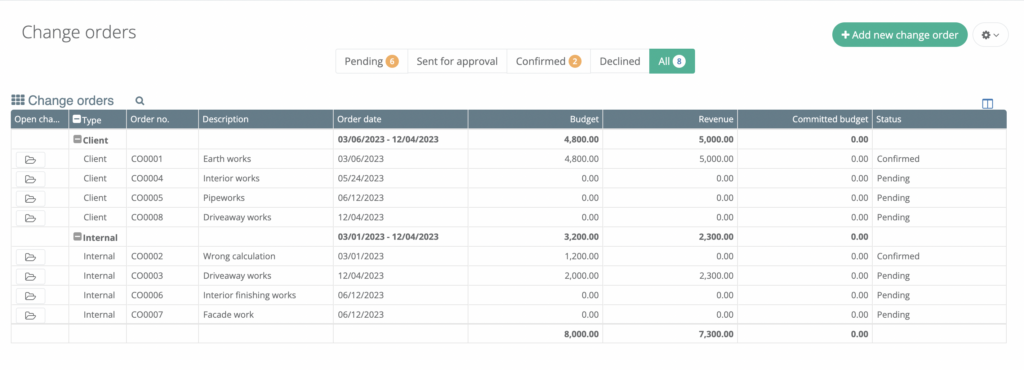Change orders in construction are amendments to the original project contract, often involving alterations to a project’s scope, cost, or schedule. Change orders happen mainly because of poor planning, design changes, unforeseen conditions, specification modifications, and project client requests. To better understand what change orders are and what causes them, you can just read our in-depth article about the basics of construction change orders.
While sometimes necessary, frequent or extensive change orders can lead to budget overruns, project delays, and increased complexity in project management. Understanding and mitigating the factors that lead to change orders is crucial in maintaining project efficiency and cost-effectiveness.
The key to reducing change orders lies in meticulous planning, effective communication, and proactive management. This article explores practical strategies and real-world examples to help construction professionals minimize the frequency and impact of change orders on their projects.
Table of Contents
1. Minimize Change Orders Through Clear Project Scope
Make sure that the project’s scope is clearly defined. Many change orders arise from a lack of a clearly outlined and detailed project scope. It’s crucial that the scope is thoroughly considered and established at the planning stage of the project. Often, this is referred to by some clients as the “purpose and need” of the project. Failure to define the scope from the beginning can lead to scope drift, leading to unreasonable increases in project costs.
For instance, consider a commercial building project initially planned without a detailed scope. Halfway through construction, the client decides to add an environmentally friendly roof system that was not in the original plan. This change, not accounted for in the initial scope, leads to additional costs and delays, exemplifying how unclear initial planning can result in significant changes and increased expenses as the project progresses.
2. Implement a Structured Change Order Procedure
It is important that the contract documents clearly define the process for initiating, approving, completing, and compensating change orders. Setting up this procedure in advance helps prevent unauthorized changes and potential conflicts as the project progresses, ultimately helping to minimize disruptions to both schedule and budget. The procedure should clearly describe the steps to be taken immediately after a potential change order is identified.
For example, in a highway expansion project, suppose an unforeseen need arises to reroute a section of road due to archaeological findings. With a structured change order process, the project team can quickly move through the stages of evaluating, approving, and implementing that change. This process ensures that all parties understand the time and cost implications, thereby avoiding delays and disagreements that might otherwise arise from such an unexpected change.
3. Establish Precise Project Specifications
A large number of change orders result from specifications that are either unclear or incomplete. Project specifications need to detail various aspects of the work, including required materials, methods of execution, monitoring and evaluation procedures, delivery of contracted goods and services, and payment process. These specifications, along with the project plans, should accurately communicate the scope of work, its location, project schedule, deliverables schedule, performance criteria, and any additional unique requirements such as security measures. Omitting these elements may increase the risk of change orders.
For example, in a residential construction project, if the specifications do not clearly state the type and quality of plumbing fixtures required, this can lead to misunderstandings. Let’s say the contractor uses standard equipment, but the client later demands state-of-the-art energy-efficient models. This discrepancy due to unclear specifications would lead to the need to change the order, increasing both cost and project duration.
4. Implement a Comprehensive Quality Control Process
It’s essential to have a quality control process in place to decrease the likelihood of change orders. This process should be comprehensive, covering all aspects of the project, such as the design phase, technical document preparation, specification development, engineering revisions, as well as testing and inspection procedures, and other relevant processes outlined in the contract. The project manager must implement a control system to implement quality control measures properly.
For example, consider a large-scale commercial building project. Failure to thoroughly implement the quality control process when installing an electrical system can result in non-compliance with safety standards or malfunctions. Discovering these problems at a later stage necessitates changing orders for rework, which leads to additional costs and delays. A strict quality control system overseen by the project manager ensures that such problems are detected and corrected early, avoiding the need for costly and time-consuming changes later in the project.
5. Make Contingency Budget
A contingency budget in your project planning is a strategic approach to managing change orders. This allocated budget serves as a financial safety net, covering unexpected changes and additional expenses that might crop up during the construction process. By earmarking funds specifically for potential modifications, project managers can effectively soften the financial blow of change orders. This proactive measure not only helps maintain budgetary control but also ensures that the project can adapt smoothly to unforeseen circumstances without derailing the overall financial plan. Additionally, regularly reviewing and adjusting the contingency budget based on project progress can further enhance its effectiveness in handling sudden changes.
For example, unexpected structural issues were discovered during the renovation of an office building, leading to additional repair costs. Fortunately, the project had a contingency budget, which covered these unforeseen expenses without significantly impacting the overall project budget or timeline. This example highlights the importance of a contingency budget in efficiently managing unexpected changes and costs in construction projects.
6. Establish a Defined Subcontractor Compliance System
It is the general contractor’s responsibility to ensure that subcontractors, along with their services and products, meet or exceed contract requirements, including compliance with the federal contractor and subcontractor employment laws. It is important for project owners to have a system that monitors and verifies that proper procedures and documentation are being followed. Without careful oversight, there is a risk that contractors may expect subcontractors to be compliant when they may not be, leading to delays and the risk of time-sensitive change orders if these issues are not addressed immediately.
For example, imagine a large infrastructure project where a subcontractor is responsible for supplying critical steel components. If the contractor assumes compliance without checking and later discovers that the steel components do not meet the required standards, this can cause significant project delays. A delay in obtaining compliant materials may necessitate a change order, affecting both the project schedule and budget. A robust compliance framework would have identified this issue early, allowing for timely corrective action.
7. Reduce Risks from Unexpected Conditions
Often, cost overruns and project delays are the result of unexpected problems such as underground obstructions, hidden structural defects, or outdated electrical and plumbing installations. These problems often go unnoticed in the early stages of planning and tend to emerge only in the active stages of the project.
While not every deficiency or risk can be identified without extensive and expensive investigative procedures, it is critical for the project team to conduct a thorough assessment of the site or existing structures to identify potential problems. Implementing strong risk management strategies is also important. This includes identifying each potential cost, assessing its impact, and devising appropriate mitigation strategies. Additionally, setting aside a contingency fund in the project budget can provide a financial buffer to accommodate any changes arising from these contingencies.
8. Conduct Regular Progress Meetings with All Relevant Parties
Regularly scheduled progress meetings are crucial for the smooth running of a project. These meetings are vital to addressing potential issues before they escalate. It’s important that representatives from every discipline are involved in these discussions. It’s often unpredictable when a challenge might emerge, impacting the work either directly or indirectly. Proactive planning and ensuring the attendance of the appropriate team members can lead to timely problem-solving, ultimately benefiting the overall project.
For instance, during the construction of a mixed-use development, a progress meeting might reveal an unforeseen issue with the electrical layout conflicting with the planned plumbing routes. By having representatives from both the electrical and plumbing teams present, along with project managers and architects, a collaborative solution can be devised on the spot. This approach prevents the complication from escalating into a major problem, saving time and resources for the project.
9. Encourage Open and Transparent Communication
Effective communication is the key to avoiding disputes often resulting from communication breakdowns. This includes being clear, open, and truthful in all communications. Success is more likely when each stakeholder is committed to the project’s overall goals rather than individual interests. The term “partnership” represents a collective commitment by all team members to prioritize project goals over personal goals. Adopting this mindset benefits all parties involved and helps reduce unnecessary conflict.
For example, during renovating a downtown office building, the project team encountered an unexpected issue: the discovery of outdated electrical wiring that needed upgrading. This posed a significant challenge in terms of additional costs and potential delays.
The project manager promptly called a meeting with all key stakeholders – the building owner, the electrical subcontractor, and the general contractor. In this meeting, the subcontractor provided a detailed overview of the issue and its implications. The building owner expressed concerns about the budget, while the general contractor discussed the impact on the project timeline.
Through open and honest communication, the team collaboratively developed a solution. They agreed on a cost-effective approach to upgrade the wiring without significantly impacting the overall timeline. This decision was made possible due to the transparent communication and the commitment of each stakeholder to the project’s success over individual interests.
10. Use Change Order Management Software
In modern construction practices, leveraging technology is key to efficiency. Many construction firms are now adopting specialized software for managing change orders. This digital approach centralizes creating, tracking, and approving change orders in one secure platform. It significantly reduces errors and enhances transparency among all involved parties, including contractors, subcontractors, and clients. Using such software allows for a more streamlined process where contractors and subcontractors can easily submit change orders, and project owners can swiftly approve them. This seamless integration of technology into change order management leads to a more organized and effective workflow.
In a commercial building construction project, a firm adopted change order management software to streamline their processes. The project involved numerous subcontractors and complex designs, which previously made change order management challenging and error-prone. With the software, contractors and subcontractors could submit change requests digitally, allowing for quick, transparent review and approval by the project management team. This led to faster processing of change orders, reduced delays, and improved record-keeping, significantly enhancing the project’s overall efficiency.
Change Can Be Positive
Change orders aren’t always a negative aspect. Often, project owners issue change orders for beneficial reasons, such as adapting to new circumstances or incorporating additional work elements that might be more costly if handled by a separate contractor. These changes can include expanding the scope of work, enhancing safety features, opting for more upscale finishes, or consolidating multiple contracts into one. Sometimes, changes are driven by less favorable factors, like budget constraints or diminished project requirements.
However, for those change orders that are less advantageous, the tips provided here are intended to help readers find strategies to minimize or altogether avoid unnecessary change orders in their construction projects.
References and Further Reading
As you continue to develop your knowledge and abilities in mitigating change orders in the construction industry, remember that your education will extend beyond this point. The following is a carefully curated collection of resources, each offering in-depth insight and broad perspectives on the topics covered here. These references are essential tools in your professional arsenal, useful for both the seasoned practitioner and the novice entering the field.
- “Construction Management: From Project Concept to Completion“ by Paul Netscher: This book is a comprehensive guide to managing construction projects, offering real-world advice and practical tips that apply to reducing change orders.
- “The Construction Project Manager’s Pocket Book“ by Duncan Cartlidge: An essential read for project managers, this pocket book covers critical aspects of construction project management, including how to handle change orders effectively.
- “Construction Management: Subcontractor Scopes of Work“ by Jason A. Smith and Jimmie Hinze: Dive into the world of subcontractor management with this detailed guide that provides strategies and insights tailored explicitly for contractors.
- “BIM and Construction Management: Proven Tools, Methods, and Workflows“ by Brad Hardin and Dave McCool: Explore how Building Information Modeling (BIM) can revolutionize construction planning and reduce the need for change orders.
- Construction Industry Websites and Blogs: Websites such as Construction Dive, ConstructConnect, and The Constructor offer a wealth of articles, case studies, and the latest news in the construction industry, helping you stay up-to-date with trends and best practices.
- Online Courses and Webinars: Platforms like Coursera, LinkedIn Learning, and the Construction Management Association of America (CMAA) provide online courses and webinars covering various aspects of construction management, including strategies to minimize change orders.
Remember that the construction industry is constantly evolving, and it is essential to stay up-to-date to manage successful projects. These resources will not only deepen your understanding but also keep you abreast of the latest trends and innovations in the industry.
Written by

Taavi Kaiv
Taavi Kaiv is a construction specialist with over ten years of experience in the construction industry. Taavi is an accomplished construction project manager with many successful projects that have been completed under his guidance. Taavi holds a master’s degree in construction management from the Tallinn University of Technology. View profile
Related content
Read our other articles where you can find helpful and relevant information about construction change orders:





